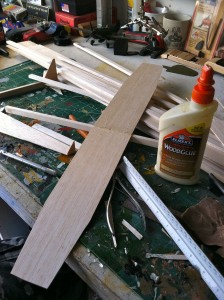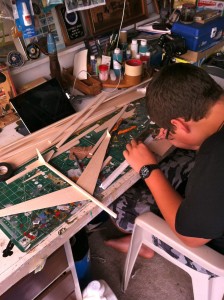The Wing is the Thing
How to keep our balsa wood airplane from being nose- or tail-heavy requires some careful planning
![]()
My son, Ian, is working on a 7th grade science project, and is studying what wing position works best for maximum glide — that is, for a balsa wood glider launched from our roof. His standard is a swept-wing design, but we’re expecting that his straight wing, either the high or low version, will make the farthest penetration into our persnickety neighbor’s front lawn.
All aircraft have a center of pressure, also called center of lift, which is normally at a fixed location (except, I assume, in a swing wing like the F-14 or Tornado). They also have a center of gravity, which is where the aircraft’s weight balances fore-and-aft. The CG depends on the distribution of fuel, baggage, etc., and is moveable. Normally, the center of gravity is placed forward of the center of pressure, which creates a corresponding down force exerted by the tail assembly, and which results in an inherently stable aircraft.
This we learned from a King Schools video on You Tube (pretty basic, as befitting Ian’s two-time liberal arts major dad):
In a straight-wing design, this is easier to visualize. We’ve been balancing his gliders on our fingertips, and we’re adding pennies (chosen because of their standard, verifiable weights) to the nose to move the CG. His straight-wing gliders all balance backward at the wing tips, but if we add nose weight such that they’re slightly nose-heavy, we wanted to know if the down force of the tail would keep them flying straight without stalling. I think (and I’m no aeronautical engineer) that if the gliders balance perfectly fore-and-aft when held lightly at the wing tips, the centers of pressure and gravity would be in essentially the same position, and hence, the gliders will nose up, since the normal down force of the tail created by having the center of gravity forward of the center of pressure would be minimal, or missing.
But, what will happen with the swept -wing version? Since the wingtips of a swept-wing design are quite a bit aft of the roots, Ian’s swept-wing model (unlike his straight-wing models) acts nose-heavy if balanced at the wingtips, but very similar to the straight-wing designs — tail heavy — if balanced at the wing roots. Will we have to add even more weight to the nose to counteract the extra weight of the swept wings behind the CG?
Next step: three more designs–one high-wing, one low-wing, and one high-wing with dihedral (wings bent slightly upward at the roots.)
Edwards AFB has nothing on us. A wobbly step ladder to the roof and a few free hours after school are all we need. (And even Mommy approves.) Stay tuned for our flight test data.
/https://tf-cmsv2-smithsonianmag-media.s3.amazonaws.com/accounts/headshot/Sotham_photo.jpg)


/https://tf-cmsv2-smithsonianmag-media.s3.amazonaws.com/accounts/headshot/Sotham_photo.jpg)